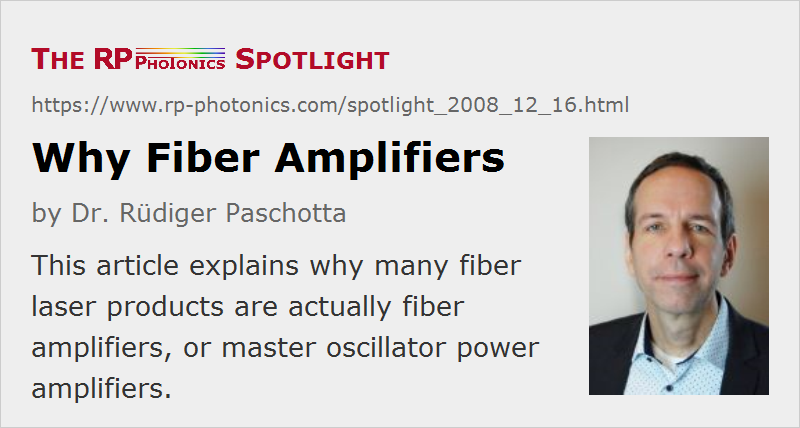Why Fiber Amplifiers
Posted on 2008-12-16 as part of the Photonics Spotlight (available as e-mail newsletter!)
Permanent link: https://www.rp-photonics.com/spotlight_2008_12_16.html
Author: Dr. Rüdiger Paschotta, RP Photonics AG, RP Photonics AG
Abstract: This article explains why many fiber laser products are actually fiber amplifiers, or master oscillator power amplifiers.
Ref.: encyclopedia articles on fiber lasers, fiber amplifiers, high power fiber lasers and amplifiers, master oscillator power amplifier; The Photonics Spotlight 2008-06-06

Some time ago I wrote an article on "Fiber Lasers Which Are No Fiber Lasers". I explained that many "fiber lasers" are actually fiber amplifiers, or MOPAs = master oscillator power amplifiers, also called MOFAs = master oscillator fiber amplifiers. However, I forgot to discuss why this is the case. There are actually different reasons.
In fiber lasers, the optical intensities in the fiber core are very high, even for moderate power levels because the effective mode area is rather small. For high power fiber lasers, the intensities are extremely high, even when large mode area fibers are used. In a fiber amplifier, the maximum occurring power in the fiber equals the output power (apart from some small coupling losses), whereas the intracavity power in a laser is higher. Particularly the average intensity in the fiber can be lower when an amplifier rather than a laser setup is used. This reduces the strength of nonlinear effects, which are often limiting the performance of fiber devices.
Another issue is that certain properties of the output would be difficult to control with a direct laser approach. This applies to the optical bandwidth, to wavelength tuning, and particularly to cases where short or ultrashort pulses are required. It is much easier to control such properties in a low-power seed laser, and to more or less preserve them in the fiber amplifier.
Unfortunately, there are also disadvantages of using an amplifier. Obviously, the complexity of the system gets larger, and usually one requires more than one pump source. A high-gain amplifier is particularly sensitive to optical feedback, so one often requires at least one optical isolator at the output. Also, an amplifier increases the laser noise. Finally, the output power may quite sensitively depend on the amplifier's pump power, unless strong gain saturation is achieved (as is often the case).
This article is a posting of the Photonics Spotlight, authored by Dr. Rüdiger Paschotta. You may link to this page and cite it, because its location is permanent. See also the RP Photonics Encyclopedia.
Note that you can also receive the articles in the form of a newsletter or with an RSS feed.
Questions and Comments from Users
Here you can submit questions and comments. As far as they get accepted by the author, they will appear above this paragraph together with the author’s answer. The author will decide on acceptance based on certain criteria. Essentially, the issue must be of sufficiently broad interest.
Please do not enter personal data here; we would otherwise delete it soon. (See also our privacy declaration.) If you wish to receive personal feedback or consultancy from the author, please contact him, e.g. via e-mail.
By submitting the information, you give your consent to the potential publication of your inputs on our website according to our rules. (If you later retract your consent, we will delete those inputs.) As your inputs are first reviewed by the author, they may be published with some delay.


Connect and share this with your network:
Follow our specific LinkedIn pages for more insights and updates: